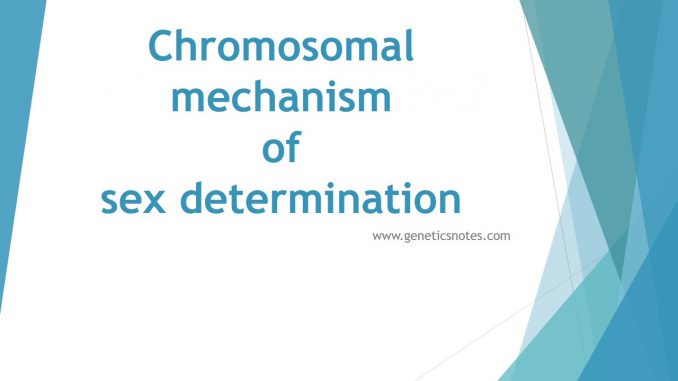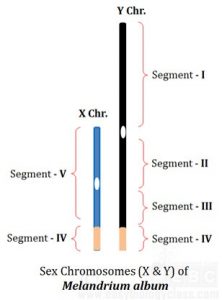
Chromosomal mechanism of sex determination
#Sex determination:
- Sex determination is the process by which the male and female gametes after fusion produce a zygote which develop the property of one sex or the other sex.
- Sex determination completes after fertilization
#Sex differentiation:
- It is the chain of developmental processes by which the genetically determined sex becomes translated into characteristic structure, functions and behavior pattern.
- Sex differentiation begins after fertilization and continues throughout embryonic development, childhood and adolescence.
Chromosomal mechanism of sex determination in animal
- Male and female differ from each other in respect to either number or morphology of sex chromosome (X and Y chromosomes). Autosomes do not differ between two sexes.
XX female-XY male type:
- In this type of sex determination, both sexes have got even number of sex chromosome; female have two X chromosome (XX) and male have one X and one Y chromosome (XY).
- Female are homogametic (XX) and after gametogenesis produces ova (female gamete) containing one X chromosome.
- Male are heterogametic and after gametogenesis produces two different types of sperm (male gamete); 50% sperm containing X chromosome and other 50% sperm containing Y chromosome.
- In fertilization; when X ova is fertilized by X sperm; it will produce XX female and when X ova is fertilized by Y sperm; it will produce XY male.
- This XX female and XY male mechanism of sex determination is common in Human as well as Drosophila and in plants.
There are certain variation in chromosomal mechanism of sex determination in different organisms;
i. XX female –XO male type:
- In this type of sex determination, female possess normal pair of autosomes and normal sex chromosome (XX) while male possess normal pair of autosome and single X chromosome but no Y chromosome (XO).
- During gametogenesis female produces normal gametes containing a single X chromosomes
- During gametogenesis in male (spermatogenesis), two types of gametes are produced; one type containing X chromosome while other type lack sex chromosome.
- If the female gamete (ova) is fertilized by a sperm containing X chromosome, it will result in normal zygote containing XX chromosome and finally develops normal female (XX).
- If the female gamete (ova) is fertilized by sperm lacking sex chromosome (O), it will results XO zygote and finally develop XO male.
- This type of sex determination is common in grass hopper and some bugs.
- In human this is an example of genetic disorder called Turner’s syndrome in Human.
ii. ZW female-ZZ male:
- This mechanism is just reverse of XX female and XY male.
- In some organism such as Fowls, amphibian, reptiles, some fishes and butterflies, moths and in some plant species Frageria orientali., female are heterogametic (ZW) while male are homogametic (ZZ).
- Male chromosome is designed as ZZ while female chromosome is designed as ZW.
- In this example, female gamete determines the sex of individuals.
- During gametogenesis, male produce similar type of sperm containing one Z chromosome, while female produces two types of gametes; one type containing Z chromosome and other type containing W chromosome.
- When Z chromosome containing ova is fertilized by Z sperm, it will result in male offspring. Similarly when W chromosome containing ova is fertilized by Z sperm, it will result in female offspring.
- ZW-ZZ mechanism of sex determination is similar as XX-XY mechanism except it is reverse.
Sex determination in plants:
- Mechanism of sex determination in plants varies from genus to genus and species to species.
- Angiosperm are flowering plants. Some plants are dioecious or unisexual (male and female occurring individually) and most are monoecious or bisexual (male and female organ in same plant body or in same flower).
- Monoecious plants are of two types:
- Monoecious plants with unisexual male and female flowers in same plant body (sporophyte). Examples;
- Monoecious pant with male and female organs in dame flower. Such monoecious pant are known as hermaphrodite.
- In monoecious plants, there is no special sex chromosome however formation of ova and pollen is accomplished by histological differentiation.
- In dioecious plants, different cases of sex determination have been found:
- Mechanism of sex determination in plants are explained by genic theory, environmental theory and chromosomal theory.
Examples: chromosomal mechanism of sex determination in plants
- Genetic information of sex is located on chromosome. In animals, sex chromosomes are responsible for sex differentiation but in plant, it could be autosomes or sex chromosomes.
- In some selected plant species sex chromosomes have been identified and the expression of sex chromosomes seems to be biologically justified.
i. Normal XX female-XY male type:
- This is a very common mechanism of sex determination in most plants.
- For eg. In a bryophyte Sphaerocarpus,
- Sphaerocarpus is a haploid plant with 7 autosomes and a sex chromosome. In male gametophyte has (7A+Y) and female has (7A+X) chromosome.
- Fusion of male gamete and female gamete give a zygote (14A + X+Y) chromosomes.
- Zygote then develops into sporophyte and under goes meiosis producing haploid gametes of two types; one containing 7A+Y and other gamete type containing 7A+X chromosome.
- 7A+Y develops into male gametophyte and 7A+X develops into female gametophyte.
ii. XY male and XX female: Melandrium album
- It is a model plant for genetic study for sex determination of plants.
- It has total chromosome of 12 pairs, among them 11 autosomes and 1 sex chromosome. A+XX; female and A+XY; male
- X and Y sex chromosome of Melandrium is similar to that of human or Drosophila but mechanism of sex determination is different from usual XX-XY system.
- Y-chromosome play crucial role in sex determination in M. album. Y chromosome contains two main genes, they are;
- Male determining gene
- Female suppressing gene
- Both genes are necessary for production of fertile anther in male plant.
- Y-chromosome is longer than X –chromosome and during meiosis (spermatogenesis) in male plant, X and Y chromosome form heteromorphic bivalent and these chromosome divides into five segments. These segments control the development of sex of plant.
- Chromosome Y have 4 segments (I, II, III and IV) and chromosome X has two segments (IV and V). Segment IV is common in both X and Y chromosome.

- Segment I: Contains gene that suppress femaleness and inhibit development of female structure in flower
- Segment II: contains gene that initiate anther development
- Segment III: also initiate anther development
- Segment IV: homologous region of both X and Y chromosome, helps in homologous pairing during meiosis.
- Segment V: It is present in X Chromosome and contains gene for femaleness in absence of Y chromosome
- Female plant is homogametic (XX), it only produce single type of gamete containing X-chromosome. Male pant is heterogametic (XY) and it produce two types of gametes; one with Y-chromosome and other with X-chromosome.
- When X chromosome containing male gamete fuse with female gamete, it will develop into female plant and produces female flowers.
- When Y chromosome containing male gamete fuse with female gamete, it will develop into male pant and produces male flower.
- If segment I is deleted from male plant then it will produce bisexual flower ( because segment V of X chromosome expresses femaleness in absence of segment I of Y chromosome and segment II and III expresses anther formation, so bisexual flower with both male and female organs develops)
- Melandrium album occurs in diploid (2n), triploid (3n) and tetraploid (4n) forms. In each form presence of Y- chromosome irrespective of number of X-chromosome and autosome produces male plant.
